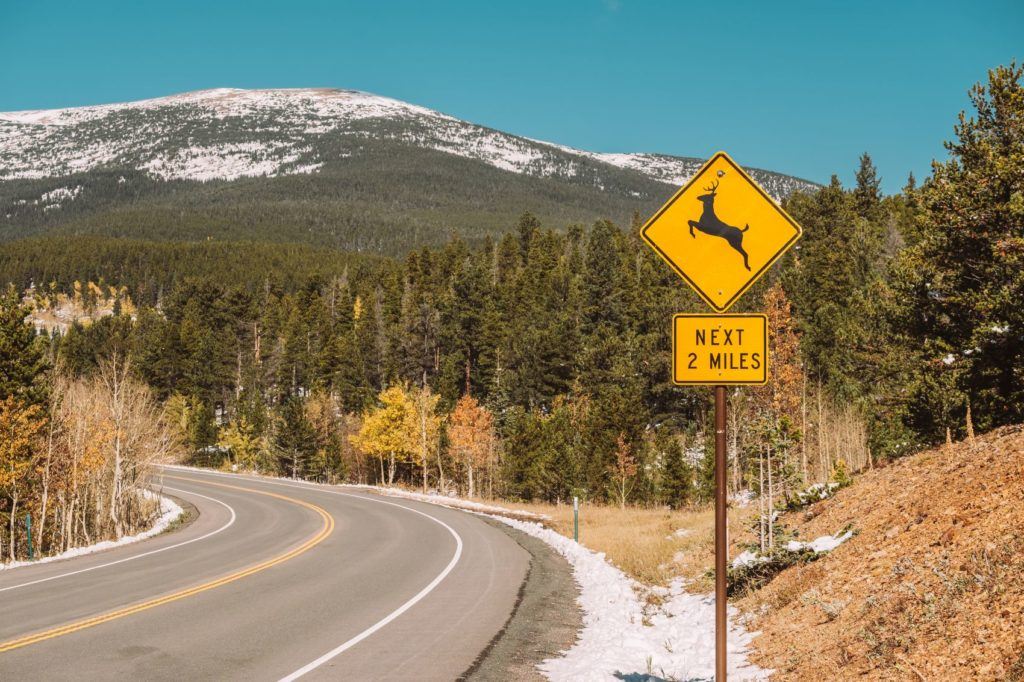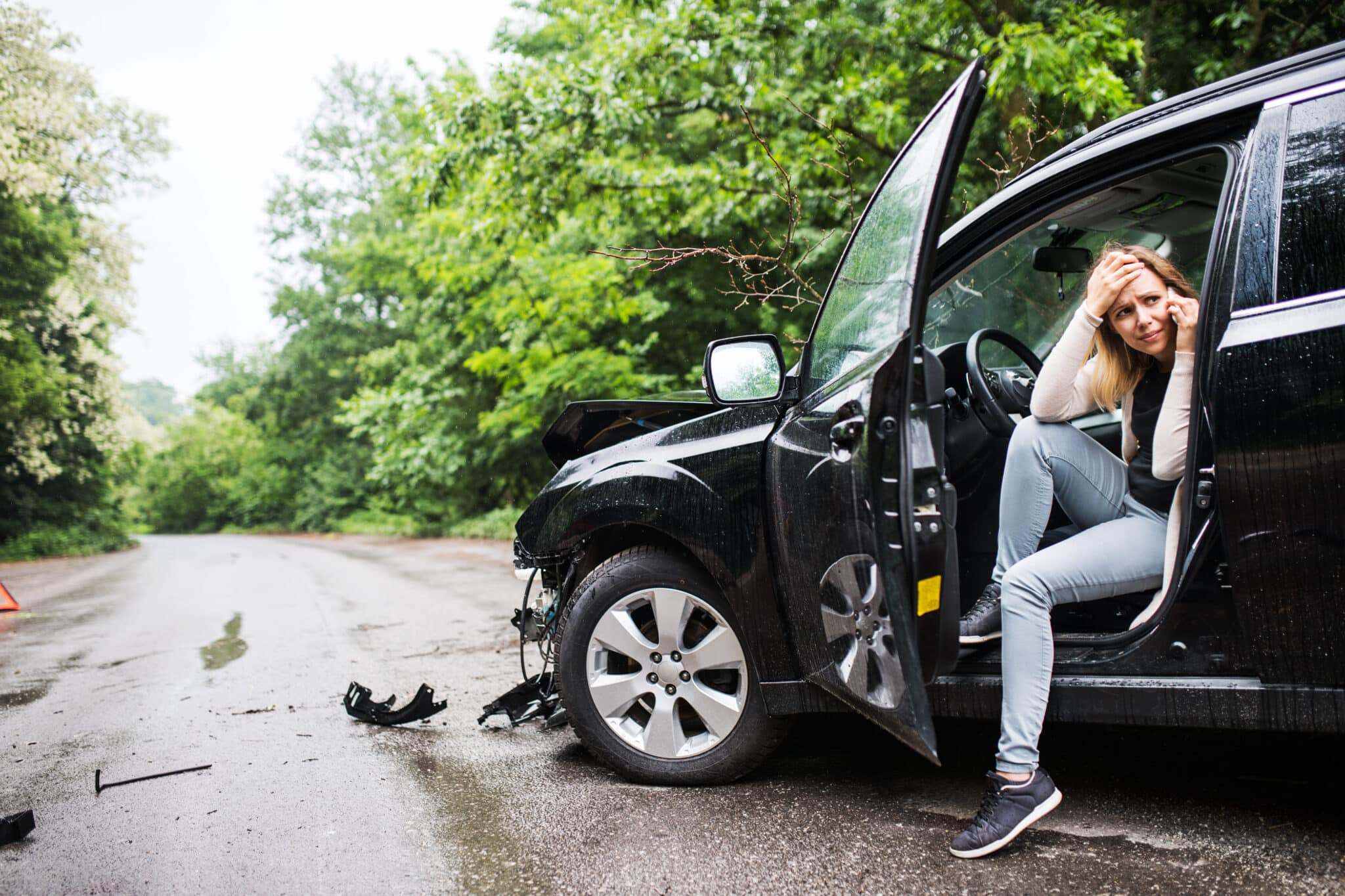Stay calm if you have just hit a deer. Collisions with wildlife rarely cause harmful human injuries, and your vehicle can be fixed. Follow the advice of law enforcement when they arrive on the scene, along with the tips below.
#1 Move Your Vehicle Off The Road (If Possible)
If your car is inoperable after the collision, do whatever is necessary to get it pulled over to the side before another vehicle comes your way. That may mean contacting an auto club or towing service to move your vehicle if necessary. If you can operate your vehicle after a collision with a deer, switch on your emergency flashers, drive out of any immediate danger, and park it in a safe area on the shoulder.
You want to eliminate any possibility of a collision with another fast-moving car, which can present far more danger to yourself and your passengers than hitting a dear. A U.S. Department of Transportation study found there were no human injuries in over 95 percent of wildlife vehicle crashes. However, you still have to consider other motorists on the road.
Since deer are active in both the early morning and evening, and certain times of the year, getting your vehicle over as far as possible is important. It might be hard for other motorists to see your vehicle until it’s too late.
This cannot be overstated and is a critical step after you have struck a deer. Regardless of if injuries occur, or if you were in a single car collision, make immediate contact through 911. Remain calm and explain the situation. The 911 operators know what to do and will dispatch the authorities.
For future reference: Consider placing reflective safety devices in your vehicle. When a collision occurs at night, place them in the area of the accident so the police and other motorists can see you.
#3: Gather & Submit Documentation
If the collision causes injuries or any vehicle damage, take down detailed notes for your own record. Law enforcement will also file an official traffic report, but you want to ensure their records line up with yours. That way there is no trouble when filing a claim afterwards.
When you hit a deer, you may have to complete a report of the accident. This will be important in fulfilling any insurance claim requirements. If possible, include pictures, video or any other evidence at the time of the accident. You’ll want photos of the general area, the road, damage to your vehicle, and any injured parties.
If there are witnesses to the incident, you’ll also want to document what they saw and record where and how you can contact them.
#4: Steer Clear of The Animal
An injured or traumatized deer is a safety hazard, as it can still have enough strength to injure you or anyone else at the scene. Do not touch it or try to attend to its injuries. You are not responsible for the medical care or disposal of the animal. Local authorities and game wardens in the area are usually responsible for any expenses concerning the animal’s care, treatment, and cleanup of the accident scene.
However, if the animal is no longer living and you want to use it for consumption, you’ll need a permit to do so. If you don’t follow that process, fail to report the accident, and illegally remove the deer, you are in violation of state laws.
#5: Make Sure Your Vehicle Is Safe To Drive
If the impact with the deer was major, you’ll want to check for tire damage; shattered windshields and headlights; bent mirrors and fluid leakage; broken hood latches and door handles; and other loose parts or strange engine sounds. You don’t want to presume that you’ll drive away automatically from a collision with an animal, even if it was small.
Call roadside assistance, either through your factory warranty or your insurance provider, or a tow truck company when in doubt. You can also ask police officers on the scene for their advice as they respond often to accidents and collisions. They can help you determine if your vehicle is safe to drive if you have just hit a deer.
#6: Contact Your Insurance Agent
Your insurance agent will want documentation as quickly as possible after you hit a deer. That means obtaining the official law enforcement report in addition to your own personal documentation. If your vehicle sustains damage or injuries occur, connect with your insurance company right away so your agent can process the claim.
Comprehensive insurance is necessary for a collision involving an animal. The sooner you get the claim filed, the sooner you can receive compensation for repairs and get this traumatic event behind you.
#7: Find An Insurance-Approved Body Shop
Once you contact your agent, they can provide a list of approved body shop repair centers. You’ll want to receive an estimate for your insurance coverage approval. A collision involving a deer or any other animal can be a costly proposition. Average costs for auto body repair can be in the thousands of dollars, and when you include any injuries in the mix, expenses can escalate.
Consult an auto body expert as soon as possible after you hit a deer.

Can You Be Traumatized After Hitting a Deer?
Yes, this is entirely possible, and it may stem from a couple of different sources. The first is that you may feel guilt and remorse after hitting an animal, such as a deer. However, that will probably subside in time as you didn’t hit the deer intentionally.
A more significant concern may be the anxiety and fear you experience the next time you drive. Although hitting a deer rarely ever causes injuries to the vehicle occupants, you may feel overwhelmed by all the “what if” scenarios. For example, what if it had been another car, or what if it had been another person, instead of a deer. You may feel that another accident of some kind is inevitable because you recently hit a deer. If so, it’s okay, and it’s perfectly normal.
According to the Anxiety & Depression Association of America (ADAA), in the days and weeks following an accident, a person may experience Post Traumatic Stress Disorder (PTSD) in the form of anxiety, depression, fearfulness, and even reoccurring nightmares about the accident. If you find yourself in this situation, talk to your doctor about PTSD and a possible treatment plan. Similarly, the ADAA also provides a number of resources to help people cope with anxiety and depression.
How To Avoid Deer In The Future
It’s important to remember how little time we have to react when driving. Even if you have immaculate reflexes, it takes precious time and distance before you can slow your vehicle or alter course. Deer are generally hard to see and move suddenly, which makes for a dangerous, potentially unavoidable combination.
You can reduce your chances of hitting a deer with these tips and best practices.
Although collisions occur with deer on a fairly regular basis, be aware of the times of year and hours of the day you travel. Also, watch for deer crossings and other signage that will alert you to deer in the area.
No one sets out to hit a deer, but it can happen unexpectedly. Awareness is the key and if it occurs, follow the cautionary information given here and any outcome should be less traumatic than the initial impact with a runaway deer.
Dominic LoBianco is a contributing author on behalf of Vorhees Law Firm. Dominic covers a wide array of themes and topics ranging from safe driving tips, to revamping your morning commute, and even vehicle collision repair.


